Content
- With a hybrid topology, two or more topologies are combined in a network design. Networks are rarely designed with a single topology type. For example, you can combine a star topology and a bus topology to take advantage of both topologies.
- Two hybrid topology types are commonly used: Star/Bus topology and Star/Ring topology.
Star/Bus
- In a star/bus topology, several star topology networks are linked to a bus connection. When the star configuration is busy, you can add a second star configuration and connect the two star topologies using a bus connection.
- In a star/bus topology, if a single computer fails, the rest of the network is not affected. However, if the central component, the so-called hub, that connects all computers in a star topology to each other, fails, all computers connected to that component fail and can no longer communicate.
Star/Ring
- In the star/ring topology, the computers are connected to a central component as in a star network. However, these components are wired in the form of a ring network.
- If a single computer fails, the rest of the network is not affected, as with the star/bus topology. Using token passing, every computer in a star/ring topology has the same communication opportunity.
- This allows a higher network traffic between segments than with the star/bus topology.
Further Information
Related articles
-
Bus topology (Snom Service Hub)
-
Hybrid topologies (Snom Service Hub)
-
Mesh topology (Snom Service Hub)
-
Network Topologies (Snom Service Hub)
-
Ring topology (Snom Service Hub)
-
Star topology (Snom Service Hub)






